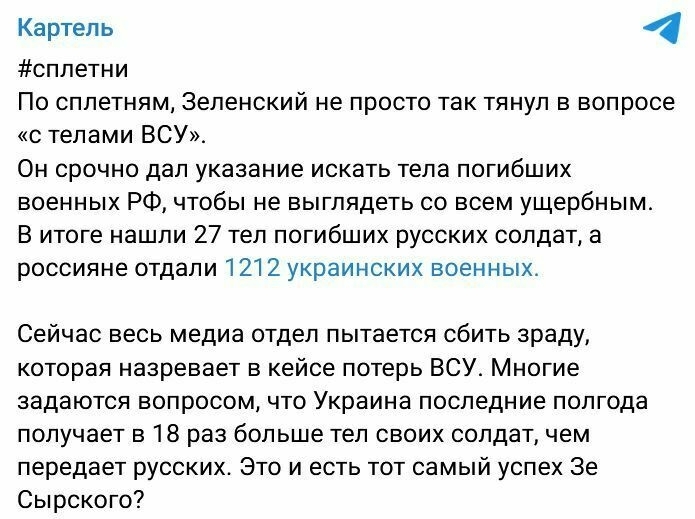Verification within Meta’s Third-Party Fact-Checking Program
Information is being spread online claiming that Ukraine allegedly suffers greater military losses than Russia. As proof, the exchange of bodies of fallen soldiers on June 11, 2025, where Ukraine received 1,212 bodies of fallen soldiers, while Russia, according to the Russians themselves, received only 27, was cited.
This is fake. According to various independent estimates, Russia suffers greater losses than Ukraine. It is likely that due to the offensive, Russia has more bodies of fallen Ukrainian soldiers than Ukraine has of Russian ones.
Screenshot of the post
The link between total losses and repatriation of bodies
Ukraine does not comment on how many bodies of Russian soldiers have been returned since the beginning of the invasion. This information is also not publicly available. Therefore, it is impossible to verify the Russian claims about the number of bodies received at this time.
In addition, Russia manipulates the figures regarding the bodies of Ukrainian soldiers handed over. Minister of Internal Affairs of Ukraine Ihor Klymenko stated that during recent repatriations, Russians also handed over bodies of Russian soldiers, mixed in with the bodies of Ukrainians.
If we assume that Russia hands over more bodies, this is likely explained by the course of hostilities. Russia has been on the offensive for much of the invasion, while Ukraine defends. Some bodies of fallen Ukrainian soldiers remain in territories occupied by Russia.
In any case, the statistics of transferred bodies are incorrectly correlated with the overall number of losses. According to independent sources, since 2022, Russia has lost significantly more soldiers than Ukraine.
Loss statistics confirmed from open sources
Mediazona, together with the BBC Russian service and a team of volunteers, maintains a name-by-name list of fallen Russian soldiers compiled from open sources. More than 111,000 killed Russian servicemen have been confirmed by name. Not every death becomes public, so the real losses are higher.
There are also counts of Ukrainian losses. For example, the Book of Remembrance for Those Who Fell for Ukraine is a project founded on July 22, 2014. Its team tracked combat and non-combat losses of Ukraine in the Anti-Terrorist Operation/Joint Force Operation zone, and now documents losses during the full-scale invasion. They update the information irregularly, so the data may be outdated.
From open data, the authors of The Book of Remembrance established about 24,500 fallen soldiers whose names are known, 15,000 missing, and 3,400 prisoners between February 24, 2022, and November 14, 2023. According to researchers, the number of deaths was at least 70% of the total number of combat and non-combat deaths in the ranks of the Armed Forces of Ukraine, the Security Service of Ukraine, and the Ministry of Internal Affairs. That means the real number of deaths could be more than 30,000. The number of wounded amounted to about 90–100,000 people, but the vast majority of soldiers with injuries or concussions continued service or planned to return to their units after treatment.
Loss statistics from American and British sources
Analysts of the American CSIS (Center for Strategic and International Studies) in an article from June 3, 2025, claim that 250,000 Russian soldiers have died, and Russia’s total losses amount to 950,000. According to CSIS analysts, Ukraine lost between 60,000 and 100,000 killed, while total losses amount to 400,000.
On June 12, 2025, the UK Ministry of Defence mentioned 250,000 killed and missing Russians and 1 million total losses.
On November 26, 2024, The Economist reported that at least 60,000–100,000 Ukrainian soldiers had been killed. Journalists relied on leaked or officially published reports of intelligence agencies, defense officials, researchers, and open sources of information. Likely, about 400,000 more were wounded in ways that prevent them from continuing combat.
